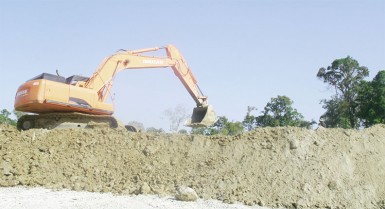A Guyana Geology and Mines Commission (GGMC) Management and Systems Review undertaken in February and targeting the its Mines, Land Management and Geological Services Division has alluded to what a mining source has described as “evidence of outrageous irregularities” in the mining sector including a “tendency towards landlordism,” which the report says “has taken over the mining industry.”
The report calls on the GGMC to tackle the reform of the law to treat with what it says is “the growing menace of landlordism and non-beneficiary occupancy” which it says are strangling the potential growth of the mining sector.
In support of its assertion, the report states that “at the end of 2013 the list of claims in existence (on the GGMC website) showed 72 claims held by Bai Shan Lin though they show as abandoned [at] 31st March 2014.” The report goes on to state that “in the current list of claims there are new claims registered to Bai Shan Lin. How Bai Shan Lin, a Chinese corporation with non-Guyanese owning the beneficial interest in the company was allowed by the Mines Division to apply for these small scales is indeed a mystery. This goes to the heart of a non-appreciation of the intent and fact of the law and is indeed worrying,” the report says.

The report’s take on land management irregularities also alludes to the fact that insofar as mining is concerned the entire Region Nine has been placed on “administrative hold” since 1989, a circumstance that has “no legal standing given that no Notice of Closure is in effect.” Additionally, the reviewers could find on record “no written instruction to put the area on hold.” The report says that as far as the commission is aware the closure of Region Nine to mining resulted from “an oral instruction emanating from the Prime Minister’s Office, the then Minister for Mines and Minerals. As a result no new applications are processed within this region and all applications put on
indefinite hold.” It said the circumstance was “highly improper” and called for the status quo to be rectified “to allow citizens to undertake legitimate mining activities.”
Meanwhile, the report says that “if the state of landlordism that was evident in the small scale (mining) system is to be frowned on, then the state of ownership of prospecting permits (medium scale) and mining permits (medium scale) could only be described as scandalous.” The report goes on to state that while a medium scale mining permit has a size of up to 1,200 acres “there are persons holding in excess of 500 prospecting permits (medium scale) and 100 mining permits (medium scale).
The 50-page report (excluding appendices) meanwhile, is calling for “further investigation into allegations of persons with state lands arising out of claims that officers of the GGMC utilize what it describes as their ‘preferred knowledge of relinquished, cancelled or expired licenses to advise private persons of the upcoming availability of lands for private consideration. “Whether corruption is involved with individuals informing miners that areas are vacant and subject to new locations, requires further investigation with records and access to personnel which was not available in this initial investigation,” the report says, adding that while, in recent times, there has been an attempt in some areas to effect a stricter adherence to the law, much of the recent public concern with the commission’s management of prospecting licences has had to do with “the perception that vacant land is distributed in an unfair way or that land becomes vacant and is acquired by a third party in a way that is not understood.”








